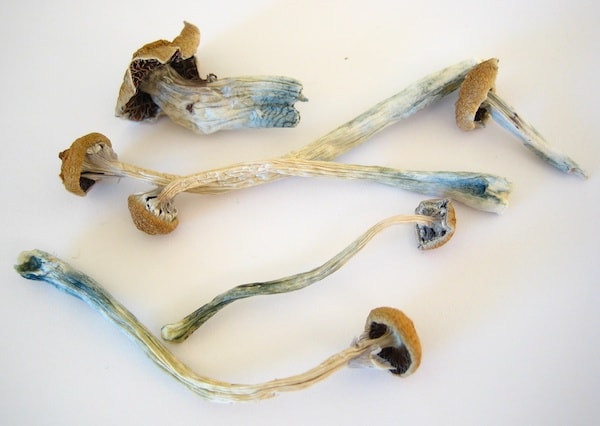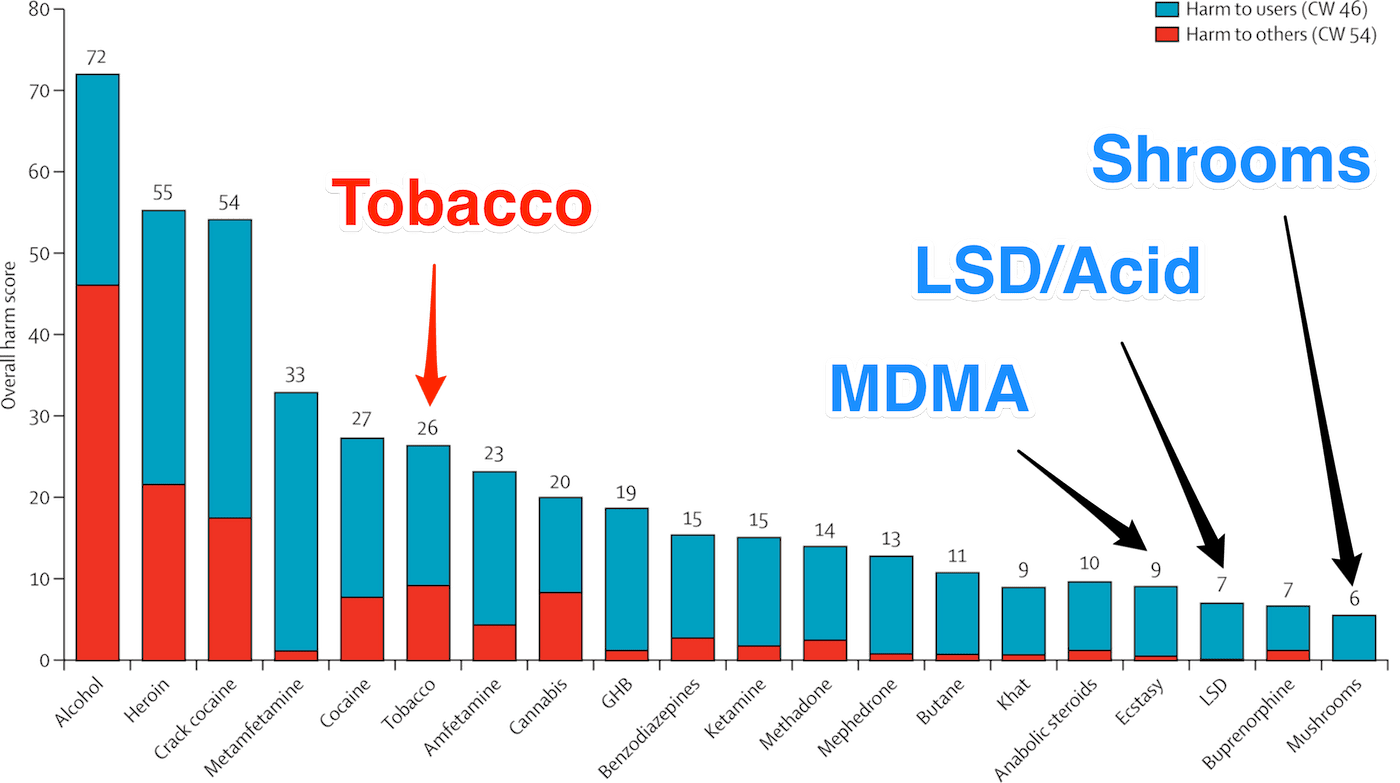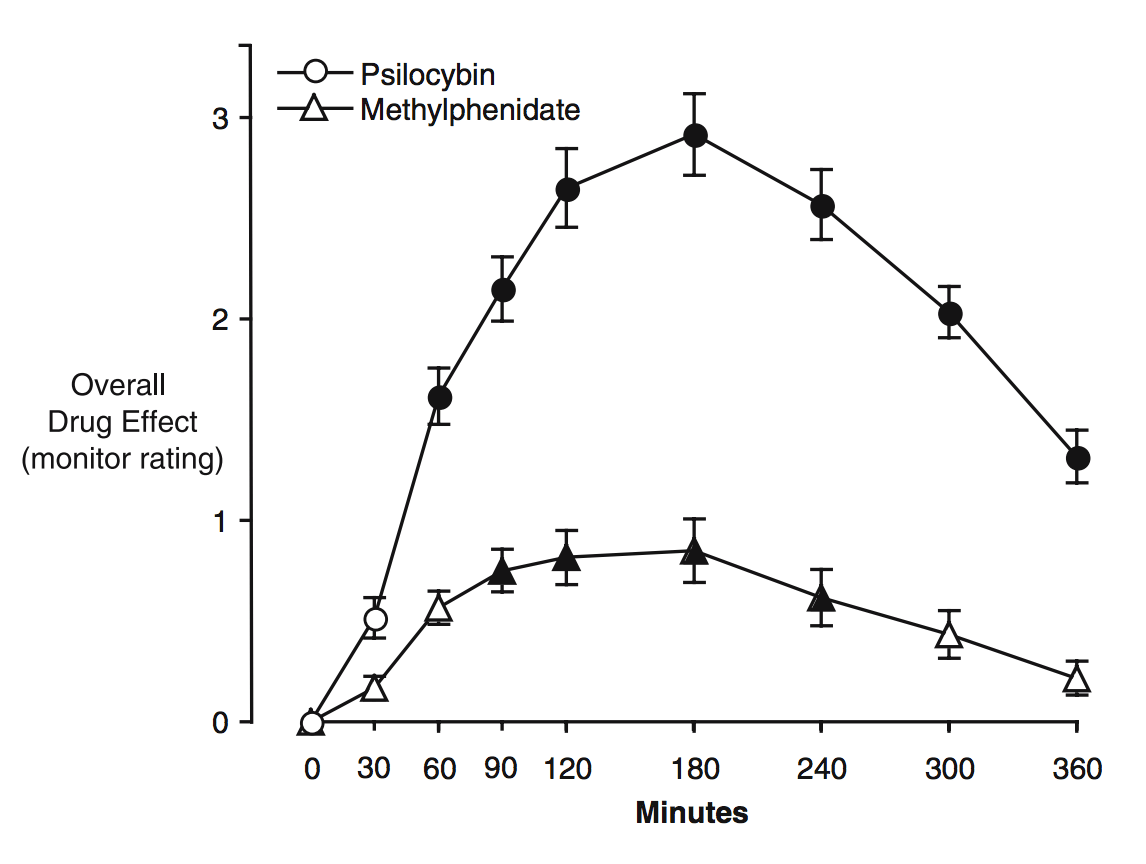Quick info
| Topic | Info |
|---|---|
| Safety in lab studies | Excellent safety track record to date in lab studies1 |
| Active ingredients | Psilocybin, psilocin |
| Street names | Shrooms, magic mushrooms, psychedelic mushrooms, mushies, liberties |
| Risks | 1. ~8 hour stressful bad trip 2. Doing something unsafe due to impaired perception or judgement 3. Psychotic reaction particularly in individuals with schizophrenic relatives 4. Visual changes that in extremely rare cases can last for weeks or years |
| Temporary desirable effects (~6 hours) | Joy/intense happiness, peace/harmony2 |
| Long term desirable effects | In therapeutic settings: Increased well-being, increased self-confidence, reduced addiction342 |
| Temporary side effects (~6 hours) | Anxiety, impaired judgement |
| Medical potential | In combination with therapy, as treatment for cancer-related emotional distress, general emotional distress, and addictions (e.g. smoking addiction, alcoholism) |
1. 🍄 Shrooms are a psychedelic drug, with psychedelic effects
The word shrooms refers to magic mushrooms. Magic mushrooms are a kind of mushroom that contain psilocybin.
Psilocybin is a psychedelic compound found in certain mushrooms.
In the US, most people eat them dried. People dry them so that they can maintain their potency when stored.
Dried shrooms look something like this:

What does it mean that Shrooms are psychedelic?
In the case of shrooms, it means that they alter your mindstate for around ~6 hours. Users in psilocybin research often describe the state as being dreamlike, or as if the world is not real.
Psilocybin can make you feel both positive mood, and negative moood. Moods can change rapidly.5
“People describe being in touch with awe-inspiring elements, with something sacred. They describe a sense of infinite love, a sense of peace, humility, being transported back into their lives,” said Ross, an associate professor in the NYU Department of Psychiatry. “They described a sense of internal and external oneness.”4
Psilocybin has also been shown to produce mystical or peak experiences, which may be involved in the medical uses.5
“To my utter amazement,” he would later recall. “I soon discovered in my visual field the emergence of an exquisitely beautiful, multidimensional network of intricate, neon-like geometric patterns … I recognized life within the undulating designs and began to feel as though I somehow could enter into the energy flowing between them … My awareness was flooded with love, beauty, and peace beyond anything I ever had known or wildly imagined to be possible.”4
2. The safety profile of shrooms might surprise you
“Since the early 1990s, approximately 2000 doses of psilocybin (ranging from low to high doses) have been safely administered to humans in the United States and Europe, in carefully controlled scientific settings, with no reports of any medical or psychiatric serious AEs, including no reported cases of prolonged psychosis or HPPD (Studerus et al., 2011).”1
“Hallucinogens generally possess relatively low physiological toxicity, and have not been shown to result in organ damage or neuropsychological deficits (Strassman, 1984; Gable, 1993, 2004; Halpern and Pope, 1999; Hasler, et al., 2004; Nichols, 2004; Halpern, et al., 2005).”6
“This finding is consistent with a US population (2001–2004 data from the National Survey on Drug Use and Health) based study that found no associations between lifetime use of any of the serotoninergic psychedelics (including psilocybin) and increased rates of mental illness (Krebs and Johansen, 2013).”1
“There is no evidence of such potential neurotoxic effects with the prototypical classical hallucinogens (i.e. LSD, mescaline and psilocybin).”6
“Cohen (1960) reported that only a single case of a psychotic reaction lasting more than 48 hours occurred in 1200 experimental (non-patient) research participants (a rate of 0.8 per 1000). Notably, the individual was an identical twin of a schizophrenic patient and thus would have been excluded under the proposed guidelines.” The key methods to minimize this risk are the medical condition guidlines below.6 It is not a good idea to take any psychedelics, including mushrooms, if you or any of your first or second-degree relatives have a current or past history of psychotic disorders including schizophrenia, Bipolar I or II disorder.6
A research paper ranked psilocybin mushrooms as the third safest drug (Nutt et al). All drugs can still be harmful under certain circumstances.7 A separate study also found that magic mushrooms were the drug with the lowest rate of emergency room visits after use, lower than alcohol, and even marijuana.8

3. If you’re going to take shrooms, you need to read this guide
Follow the steps on TripSafe to be as safe as possible, and have the best, most rewarding mushroom experience. Remember, no drug use is perfectly safe. But you can take shrooms in a safer manner.
We do not endorse the acquisition and use of illegal drugs. If you make the choice to use psychedelic drugs, please do your research.
A risk of mushrooms is doing something unsafe to yourself or someone else while you’re under the influence. The risk of this is reduceable to near zero by only taking shrooms (“tripping”) with a trusted and sober guide who has experience supporting psychedelic sessions.
Read the guide on how to take shrooms.
4. Bad trips do happen, though research suggests they can be substantially minimized or avoided
The rates of fear and anxiety (“bad” trips) in research are surprisingly low at certain dosages. This indicates that by following certain guidelines for who should take mushrooms and how they take them, we can significantly reduce the incidence of bad trips.
At a dosage of 1.6 grams9 in a therapeutic clinical environment, we might expect 0% of people to experience some extreme fear,10 for an average of around 1 minute of strong anxiety11, and we might expect around ~45% to report a persisting positive increase in mood from this dosage
At a dosage of ~3.2 grams9 in a therapeutic clinical environment, we might expect 14% of people to experience some extreme fear,10 for an average of around ~2 minutes of strong anxiety 11
At a dosage of ~4.8 grams of mushrooms9 in a therapeutic clinical environment, we might expect 86% of people to experience some extreme fear,10 for an average of around ~11 minutes of strong anxiety11
From the page on how to take shrooms.
5. Shrooms are being researched medically and show promise for depression, anxiety, general well-being, eating disorders, behavior change, addictions and more
Read our page on psychedelic therapy for info on:
- What does psychedelic therapy look like?
- Why does psychedelic therapy seem to work?
- Where can I do psychedelic therapy?
- The research on psychedelic therapy for depression, anxiety, personal growth
- How to become a psychedelic therapist
- MDMA therapy vs psilocybin therapy
- Other beneficial resources
👉 Psychedelic Therapy: Beneficial Things To Know
Read the research:
6. Shrooms and LSD are decently similar in effects
This redditor puts it well: “LSD is electric, mushrooms are spiritual. Both are trippy. Your mood and mindset is more stable on LSD, but you are able to wade into greater emotional depths with shrooms.”
Note that:
Dosage has a much greater impact on effects than substance does - 100 micrograms of LSD is roughly equivalent to 2.4g of shrooms, and 100 micrograms of LSD will feel more similar to 2.4g of shrooms than it would feel to 300 micrograms of LSD.
LSD lasts longer, typically around 10-14 hours. The effects of shrooms tends to last for 4-6 hours.5 On the graph, magic mushrooms = psilocybin.

7. If you have specific medical conditions, you might be able to enroll in government-supported research using magic mushrooms
See active psilocybin studies here.
There may be studies for smoking addiction, alcohol addiction, cocaine addiction, and anxiety.
8. Shrooms are really popular
According to US government statistics, magic mushrooms have been used by 22.8 million Americans at least once.12
😮
9. Mushroom usage was associated with improved mental health, contrary to any myths
“Lifetime classic psychedelic use was associated with a significantly reduced odds of past month psychological distress (weighted odds ratio (OR)=0.81 (0.72–0.91)), past year suicidal thinking (weighted OR=0.86 (0.78–0.94)), past year suicidal planning (weighted OR=0.71 (0.54–0.94)), and past year suicide attempt (weighted OR=0.64 (0.46–0.89))”13
10. Mushrooms can have powerful long-term benefits
The sophisticated psychological assessments Griffiths conducted at two and fourteen months following the psilocybin sessions backed up the claims. In an article in Scientific American Griffiths coauthored with his fellow Heffter board member, Grob, he reported that “the data showed that participants experienced increased self-confidence, a greater sense of inner contentment, a better ability to tolerate frustration, decreased nervousness and an increase in overall well-being. Ratings of their behavior by friends, family members and work colleagues uninformed about the drug experience were consistent with the participants’ self-ratings.
More than 70 percent of the participants self-rated the experience as one of the five most important in their lives. Perhaps even more astoundingly, nearly a third rated it the single most important experience.3
More info here.
11. Shrooms may help treat addiction
“In addiction medicine, the name of the game has been to somehow block the addictive drug’s effects at the brain’s receptor sites by substituting or antagonizing at the receptor-to reduce specific cravings for one drug. So you have a medication that seems to work for this drug or that drug.”
“What’s really exciting about psychedelics is that we are talking about addiction-rather than just alcohol addiction or nicotine addiction. It’s not about a particular drug.”4
More info here.
12. Psilocybin is legal in some countries, and companies offer paid retreats for therapeutic psychedelic sessions
It is our understanding that magic truffles are legal in the Netherlands, and in Jamaica magic mushrooms are either outright legal or the laws don’t seem to be enforced.
You can find a list of legal psychedelic retreats and legal psychedelic therapy providers on TripSafe here.
Read next
Psychedelic Therapy: Beneficial Things To Know
References
- https://www.ncbi.nlm.nih.gov/pmc/articles/PMC5367551/ [return]
- https://www.ncbi.nlm.nih.gov/pmc/articles/PMC5367557/ [return]
- Book: Acid Test [return]
- Book: Changing Our Minds [return]
- http://www.maps.org/research-archive/psilo/psilo_ib.pdf [return]
- https://www.ncbi.nlm.nih.gov/pmc/articles/PMC3056407/ [return]
- Nutt, D. J., King, L. A., & Phillips, L. D. (2010, November 01). Drug harms in the UK: A multicriteria decision analysis. The Lancet, 376(9752), 1558-1565. doi:10.1016/s0140-6736(10)61462-6 [return]
- https://www.theguardian.com/society/2017/may/23/study-hallucinogenic-mushrooms-safest-recreational-drug-lsd [return]
- https://www.ncbi.nlm.nih.gov/pubmed/27578767 [return]
- https://www.ncbi.nlm.nih.gov/pmc/articles/PMC3308357/ [return]
- https://www.ncbi.nlm.nih.gov/pmc/articles/PMC3308357/table/T1/ [return]
- https://www.samhsa.gov/data/sites/default/files/NSDUH-DetTabs-2015/NSDUH-DetTabs-2015/NSDUH-DetTabs-2015.htm#tab1-1a [return]
- https://www.ncbi.nlm.nih.gov/pubmed/25586402 [return]
